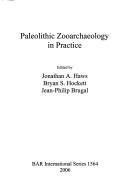| Listing 1 - 6 of 6 |
Sort by
|

ISBN: 9781841719948 1841719943 Year: 2006 Volume: 1564 Publisher: Oxford Archaeopress
Abstract | Keywords | Export | Availability | Bookmark
 Loading...
Loading...Choose an application
- Reference Manager
- EndNote
- RefWorks (Direct export to RefWorks)
Animal remains (Archaeology) --- Paleolithic period. --- Restes d'animaux (Archéologie) --- Paléolithique --- Animal remains (Archaeology). --- Restes d'animaux (Archéologie) --- Paléolithique --- Paleolithic period --- Eolithic period --- Old Stone age --- Palaeolithic period --- Stone age --- Archaeozoology --- Zooarchaeology --- Zoology in archaeology --- Archaeology --- Bones --- Animal paleopathology --- Methodology
Digital
ISBN: 9781441982193 Year: 2011 Publisher: New York, NY Springer New York
Abstract | Keywords | Export | Availability | Bookmark
 Loading...
Loading...Choose an application
- Reference Manager
- EndNote
- RefWorks (Direct export to RefWorks)
Ethnology. Cultural anthropology --- Archeology --- archeologie --- Antiquity
Book
ISBN: 9781441982186 Year: 2011 Publisher: Paris ; Berlin ; Heidelberg [et al.] Springer
Abstract | Keywords | Export | Availability | Bookmark
 Loading...
Loading...Choose an application
- Reference Manager
- EndNote
- RefWorks (Direct export to RefWorks)
Book
ISBN: 1441982183 1441982191 Year: 2011 Publisher: New York : Springer,
Abstract | Keywords | Export | Availability | Bookmark
 Loading...
Loading...Choose an application
- Reference Manager
- EndNote
- RefWorks (Direct export to RefWorks)
Human settlement has often centered around coastal areas and waterways. Until recently, however, archaeologists believed that marine economies did not develop until the end of the Pleistocene, when the archaeological record begins to have evidence of marine life as part of the human diet. This has long been interpreted as a postglacial adaptation, due to the rise in sea level and subsequent decrease in terrestrial resources. Coastal resources, particularly mollusks, were viewed as fallback resources, which people resorted to only when terrestrial resources were scarce, included only as part of a more complex diet. Recent research has significantly altered this understanding, known as the Broad Spectrum Revolution (BSR) model. The contributions to this volume revise the BSR model, with evidence that coastal resources were an important part of human economies and subsistence much earlier than previously thought, and even the main focus of diets for some Pleistocene and early Holocene hunter-gatherer societies. With evidence from North and South America, Europe, Africa, Asia, and Australia, this volume comprehensively lends a new understanding to coastal settlement from the Middle Paleolithic to the Middle Holocene.
Coastal archaeology. --- Excavations (Archaeology). --- Fishing, Prehistoric. --- Shipwrecks. --- Underwater archaeology. --- Coastal archaeology --- Human beings --- Underwater archaeology --- Prehistoric peoples --- Coastal settlements --- Land settlement patterns, Prehistoric --- Marine resources --- Fish remains (Archaeology) --- Fishing, Prehistoric --- Marine mammal remains (Archaeology) --- Coast changes --- Anthropology --- History & Archaeology --- Social Sciences --- Prehistoric Anthropology --- Archaeology --- Food --- Migrations --- Paleolithic period. --- Prehistoric peoples. --- Cavemen (Prehistoric peoples) --- Early man --- Man, Prehistoric --- Prehistoric archaeology --- Prehistoric human beings --- Prehistoric humans --- Prehistory --- Eolithic period --- Old Stone age --- Palaeolithic period --- Social sciences. --- Anthropology. --- Archaeology. --- Social Sciences. --- Antiquities, Prehistoric --- Stone age --- Archeology --- Auxiliary sciences of history --- History --- Antiquities --- Primitive societies --- Social sciences
Book
ISBN: 9781441982193 Year: 2011 Publisher: New York, NY Springer New York
Abstract | Keywords | Export | Availability | Bookmark
 Loading...
Loading...Choose an application
- Reference Manager
- EndNote
- RefWorks (Direct export to RefWorks)
Human settlement has often centered around coastal areas and waterways. Until recently, however, archaeologists believed that marine economies did not develop until the end of the Pleistocene, when the archaeological record begins to have evidence of marine life as part of the human diet. This has long been interpreted as a postglacial adaptation, due to the rise in sea level and subsequent decrease in terrestrial resources. Coastal resources, particularly mollusks, were viewed as fallback resources, which people resorted to only when terrestrial resources were scarce, included only as part of a more complex diet. Recent research has significantly altered this understanding, known as the Broad Spectrum Revolution (BSR) model. The contributions to this volume revise the BSR model, with evidence that coastal resources were an important part of human economies and subsistence much earlier than previously thought, and even the main focus of diets for some Pleistocene and early Holocene hunter-gatherer societies. With evidence from North and South America, Europe, Africa, Asia, and Australia, this volume comprehensively lends a new understanding to coastal settlement from the Middle Paleolithic to the Middle Holocene.
Ethnology. Cultural anthropology --- Archeology --- archeologie --- Antiquity
Book
ISBN: 9729969310 9789729969317 Year: 2006 Publisher: Faro Universidade do Algarve
Abstract | Keywords | Export | Availability | Bookmark
 Loading...
Loading...Choose an application
- Reference Manager
- EndNote
- RefWorks (Direct export to RefWorks)
Animal remains (Archaeology) --- Excavations (Archaeology) --- Prehistoric peoples --- Animais --- Pré-história --- Congressos --- Actas. --- Arqueologia --- Península Ibérica --- Actas
| Listing 1 - 6 of 6 |
Sort by
|

 Search
Search Feedback
Feedback About UniCat
About UniCat  Help
Help News
News